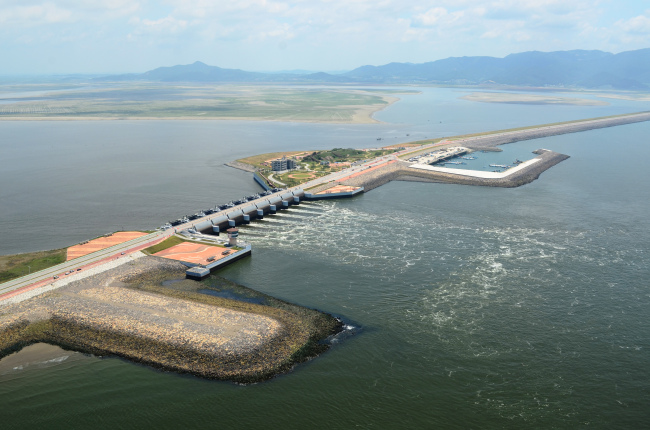Korea’s two mega hydro management projects will raise the global recognition of the country’s advanced agricultural development skills, the Korea Rural Community Corp. said Sunday.
Through the state-led Saemangeum development and reclamation plan and Yeongsangang River project, the nation aims at bolstering sustainable growth by elevating environment-friendly development skills to the top practice of futuristic government projects.
Saemangeum on the west coast in North Jeolla Province boasts the nation’s largest farming area. The surrounding region has traditionally served as the country’s water storage and grain repository, rich enough in nature and cultural heritage to raise its food security.
Now the region is the world’s largest reclamation of land, having created 401 square kilometers of “new” land. Saemangeum’s sea dike, a 33.9-kilometer landmark, is booked in the Guinness World Records as the longest man-made sea barrier in the world.
The first phase of the Saemangeum project calls for the development of eight zones from 2009 to 2020, which includes an industrial park, an eco-environmental zone, a science and research area, an agricultural zone and a tourism and leisure zone.
 |
| A sea dike sluice on Saemangeum. (KRC) |
The cream of the Saemangeum agricultural zone is the 85.7 square kilometers of farmland near the Mangyeonggang River and Dongjingang River, which takes up about 30 percent of Saemangeum’s “internal land.”
This area is set aside to be the agricultural export hub, particularly for the multigrain complex, gardening and floriculture for export, large-scale agriculture and fishery industries and agricultural industrial clusters, with facilities operated on the country’s state-of-the-art information technology,” said a KRC official.
The Yeongsangang River project is also a local benchmark of state-led eco-friendly agricultural development of the lands near the country’s fourth-largest river.
The Yeongsangang River area in the country’s southwest takes up about 23 percent of South Jeolla Province.
The chronic water shortage, due to repeated occurrence of drought and floods, has been a core threat to the province’s economy. The river area has traditionally had high demand for clean agricultural water to the province’s three rice-rich flatlands ― Naju, Songjeong and Hakgyo.
The central government has engaged in the river area’s development for more than four decades, since the project’s launch in 1972 with the construction of four dams in Jangseong, Damyang, Naju and Gwangju. The project also includes building the estuary bank for the Yeongsangang River and river dikes in Yeongam and Geumho. The river development project spans 1,260 square kilometers with an investment of about 3.9 trillion won ($3.6 billion).
The project’s goal is to secure an additional 944 million cubic meters of clean water for agricultural, industrial and drinking purposes, in addition to expanding the country’s land territory by 311 square kilometers. The KRC estimated that the mega project has dramatically enhanced the irrigation and drainage capacities, leading to greater agricultural productivity. Rice production, for instance, showed a surprising jump by 0.4 to 1 ton per hectare.
“The project is phenomenal to have achieved up to 25 percent growth in the agricultural production capacity, despite the aging farming society and the continued inclemency of weather,” a KRC official said, pointing out that frequent flooding and droughts have caused tremendous financial losses for farming households every year.
By Chung Joo-won (joowonc@heraldcorp.com)



